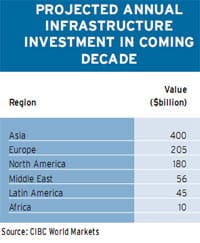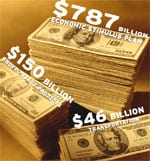Policymakers are pouring money into infrastructure projects in an attempt to head off economic disaster.
 |
|
Cohen: When stability returns, infrastructure will be attractive. |
All aspects of infrastructure will be on the rise in 2009, as the United States and other governments around the world try to spend their way out of a deep recession. President Barack Obama’s $787 billion economic stimulus plan, which was approved by Congress last month, includes $150 billion for shovel-ready projects that will boost hiring for infrastructure improvements, including $46 billion for transportation.
The Obama administration also wants to create a National Infrastructure Reinvestment Bank, which will invest $60 billion over 10 years. The new bank would offer direct subsidies, loan guarantees and long-term tax-credit bonds that could multiply the total investment to almost $500 billion of additional infrastructure spending. The plan aims to create millions of new jobs in the US construction industry, which has been hit hard by the housing crisis.
“More than 90% of the jobs created by this [Economic Recovery and Reinvestment] plan will be in the private sector,” Obama said in his first press briefing at the White House on February 9. “They’re not going to be make-work jobs, but jobs doing the work that America desperately needs done, jobs rebuilding our crumbling roads and bridges, repairing our dangerously deficient dams and levees, so that we don’t face another Katrina.”
The US interstate highway system is in need of repair and expansion, and the country’s rail network needs a major upgrade. Schools, the electricity grid, energy systems and broadband access to the Internet all will get attention. Once these projects are completed, they will leave the United States in a better position to compete globally by augmenting the economy’s productive potential, economists say, although many of the effects may not be felt until after the economy has already recovered.
Emerging market countries that were already facing tremendous infrastructure development needs before the global financial crisis hit are accelerating investments. China plans to spend more than $580 billion on infrastructure and social welfare programs through 2010. Much of the investment will be directed toward low-income housing and infrastructure in rural areas. Asia as a whole will need trillions of dollars of investments over the next decade to keep up with increasing demand for infrastructure, including airports, highways and railroads.
Russia plans $1.1 trillion of spending through 2015, with 71% of the total expected to come from private sources. Japan and most of the developed economies of Europe have all announced major public works programs to stimulate their economies, with increased spending on schools, hospitals, the environment and transportation. Latin America and Africa also have major infrastructure projects on the drawing boards.
Banks To Play Crucial Role
New funding structures have emerged to meet this growing demand, including infrastructure funds and other forms of private equity, as well as public-private partnerships. The financing, however, will depend on a well-functioning banking system.
 “Clearly there are capital and liquidity constraints affecting all financial institutions,” says Gershon Cohen, head of infrastructure finance at Bank of Scotland, part of the Lloyds Banking Group. “In order to resume arranging complex debt transactions, certainty and confidence need to return to the bank syndication and capital markets in order to be able to distribute the underwriting,” he says.
“Clearly there are capital and liquidity constraints affecting all financial institutions,” says Gershon Cohen, head of infrastructure finance at Bank of Scotland, part of the Lloyds Banking Group. “In order to resume arranging complex debt transactions, certainty and confidence need to return to the bank syndication and capital markets in order to be able to distribute the underwriting,” he says.
When some stability returns to the world’s financial systems, the infrastructure sector will be an attractive place to lend, Cohen says. In the United Kingdom the focus will be on waste-management projects, new schools and road-improvement schemes, he says. “The European agenda is being led by the French, who are looking at major multibillion-euro upgrades to their heavy-rail infrastructure,” he adds.
The scale of the need and the scope of the US economic stimulus plan are exciting, Cohen says. “However, given the capital and liquidity constraints, governments will need to play a role to assist with the funding of projects until some type of normal banking and capital markets activity resumes, otherwise volumes will fall off dramatically,” he says. Even after interbank liquidity funding returns to normal, credit spreads of 200 basis points and more will be required to make lending to the sector attractive, he points out.
“I would expect some innovation to emerge on the debt side, by way of debt funds and debt securitization vehicles,” Cohen says. “On the investment side, the natural investors in infrastructure are pension funds seeking long-term stable income to match their liabilities.”
There is little correlation between the economic cycle and the performance of infrastructure projects, which makes them a relatively safe, low-yielding investment, according to Cohen. “Given the enormous capacity in this investor sector, I would expect new funds to emerge proportionately to the increasing pipeline of projects,” he says.
 Johannes Schmidt, CEO of equity and project finance at Siemens Financial Services (SFS), based in Munich, says infrastructure financing is an asset class that stands out positively for institutional investors in the current global financial environment. Project financing offers attractive returns based on tangible long-term assets, rather than on structured paper, he says.
Johannes Schmidt, CEO of equity and project finance at Siemens Financial Services (SFS), based in Munich, says infrastructure financing is an asset class that stands out positively for institutional investors in the current global financial environment. Project financing offers attractive returns based on tangible long-term assets, rather than on structured paper, he says.
“Projects that can demonstrate an efficiency improvement will get done,” Schmidt says. “The funds will be found.” Technological improvements to energy systems drive efficiency and hence contribute to climate protection, he points out.
In the future, more new electricity-generating capacity in Germany will come from the planned big offshore wind farms than from any other source, Schmidt says. A lot of improvements could be made to existing power generating plants, particularly in the US, where there is no incentive to replace 30-year-old coal-fired plants that have been completely written off and yet still have another decade to go in their usable life spans, he says.
Cost advantages are the primary drivers for environmentally friendly investments, according to Schmidt. “It is up to regulators, and hence the governments, to put the right price tags on these investments, such as through carbon-dioxide emission regimes in Europe and tax credits in the US,” he says. According to a survey of 2,750 companies conducted by SFS last autumn, lower operating costs, a better corporate image and a desire to be seen as a good citizen are the three main reasons businesses cite for investing in new or replacement generating equipment with a low carbon footprint. Obstacles for investing in new equipment include expense and equipment availability. These hurdles will be overcome as long as governments put the right price tags in place, Schmidt asserts.
“There are significant global infrastructure investment requirements, particularly regarding energy,” Schmidt says. Approximately $3.5 trillion will need to be invested in energy projects in the next 20 years, he says. This corresponds to a six-fold increase from the current level. Planned spending on global infrastructure over the next 20 years, including water, transport, energy and healthcare, totals nearly $20 trillion, he says.
The market environment has become tougher as a result of the global financial crisis, Schmidt says. The impact of increased funding costs, balance-sheet constraints and a flight to quality has already been felt. Margins on project finance deals increased by 60 to 100 basis points in the second half of 2008, with investors becoming more selective on the quality of project participants and demanding a thick equity cushion.
Infrastructure and energy projects required by emerging market countries to sustain their economic growth are urgent, Schmidt says. Demand for project finance assets is expected to remain high in 2009 and beyond, and there is a backlog of transactions from 2008, he says.
Japanese financing institutions, such as the Japan Bank of International Cooperation (JBIC), Japan Finance Corporation (JFC) and the Japan International Cooperation Agency (JICA) provide attractive funding and loans, as well as a political umbrella for infrastructure projects worldwide, Schmidt says. Japanese trading houses also act as partners, investors and project developers. “However, it is a long and cumbersome process to familiarize yourself with these houses and to get to know their requirements,” he says.
Private Funds Make Progress
Infrastructure funds have developed rapidly since they were introduced 10 years ago, and private capital is becoming more involved in refurbishing facilities and building new assets, according to Schmidt. Nevertheless, infrastructure financing is an area where government involvement is critically important, he says.
Megatrends such as urbanization and demographic change, as well as climate change are some of the world’s toughest challenges, Schmidt says. In 2007, for the first time in history there were more people living in cities than in rural areas. Meanwhile, population growth and increased life expectancy are also putting stress on infrastructure and healthcare delivery systems.
 |
|
Schmidt: Demographic and climate change are tough challenges. |
Global project finance volume rose 13% in 2008 to $315 billion, although activity tailed off toward the end of the year as financing became more difficult to obtain, according to Dealogic. Russia’s $20 billion Sakhalin II offshore oil and gas project, completed in June 2008, was the largest project ever. The infrastructure sector ranked second to the energy sector in both volume and deal count in 2008, with $80.7 billion from 239 projects. Within the infrastructure sector, road projects accounted for 35% of the total last year, followed by port projects with 13%. The $5.3 billion Panama Canal expansion project accounted for more than half of the port sector total of $10.2 billion.
Project finance loan borrowing rose 11% in 2008 to a record $235 billion, according to Dealogic. Royal Bank of Scotland led the mandated arranger league tables with $8.1 billion of global project finance loans from 73 deals. State Bank of India was second, with $7.7 billion, followed by BNP Paribas, with $6.8 billion. Barclays led the bond bookrunner ranking, with $1.1 billion from three projects.
Saudi Arabia was the leading nation for project finance volume in the Middle East in 2008, with its $23 billion total boosted by the $10 billion Saudi Kayan Petrochemical Complex, the second-largest project finance deal of last year. Saudi Arabia will increase spending on development projects to $60 billion this year, helping to diversify its economy in the face of declining oil revenues.
By running its first budget deficit since 2001, the world’s largest oil exporter aims to bolster confidence and keep infrastructure projects on track, says Howard Handy, chief economist of Riyadh-based Samba Financial Group. “This is precisely the role that fiscal policy should play in such an unsettled economic environment,” he says.
The first of six planned new economic cities is taking shape 60 miles north of Jeddah on the country’s Red Sea coast, near the massive Petro Rabigh refinery and petrochemical complex. Construction of King Abdullah Economic City (KAEC) began in December 2005, when Saudi Arabia was approved to join the World Trade Organization. The new industrial and technology clusters were conceived and launched by the state’s Saudi Arabian General Investment Authority (Sagia) and are being financed largely by the private sector.
Saudi Arabia is investing heavily in developing its transportation infrastructure, with new ports, airports, highways and railroads getting high priority. Construction recently began on a new high-speed monorail system linking the holy cities of Mecca and Medina. Cisco, based in San José, California, will provide the network architecture for the new Knowledge Economic City in the outskirts of Medina, which will include a campus for medical research and the life sciences.
“It seems clear that public investment will have to continue at a reasonably high rate if infrastructure plans are to remain on track,” says Handy of Samba. “Indeed, at a time of wavering private confidence, the government and other public sector institutions may need to increase their equity stakes in various projects to keep them viable,” he says.
In January Saudi Arabia allocated more than $3 billion for road construction projects. The funds will be spent on new highways and 1,300 miles of rural roads to support the agricultural sector. Saudi Arabia plans to spend $400 billion on infrastructure projects in the next five years, taking advantage of lower construction costs because of the recent drop in the prices of steel, cement and other building materials.
The Asian infrastructure sector is well positioned to outperform the overall market over the first half of 2009, according to Mirae Asset Global Investments, based in South Korea. “Statistics show that the quality of infrastructure in the Asia-Pacific region is below the global average, largely due to underspending in the emerging economies,” says Raymond Cheng, portfolio manager for Mirae Asset’s Asia Pacific Infrastructure Fund. “Current market conditions provide the Asian countries with a golden opportunity to take advantage of the commodity-price correction to improve their infrastructure and boost long-term competitiveness,” he says.
Gordon Platt


